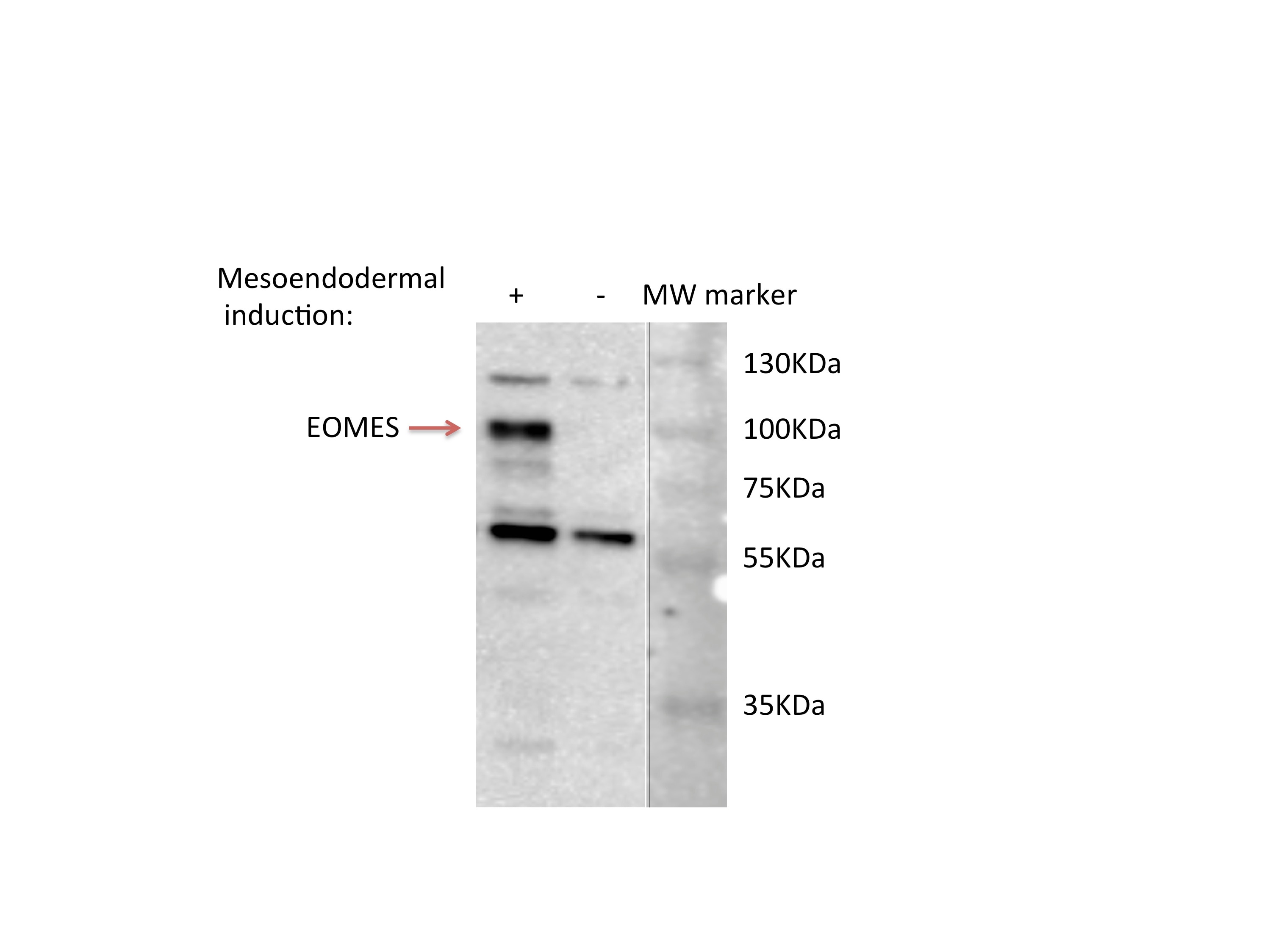Human EOMES Antibody Summary
Gly471-Pro686
Accession # O95936
Applications
Please Note: Optimal dilutions should be determined by each laboratory for each application. General Protocols are available in the Technical Information section on our website.
Scientific Data
 View Larger
View Larger
Detection of Human EOMES by Western Blot. Western blot shows lysates of BG01V human embryonic stem cells untreated (-) or mesendoderm differentiated (+). PVDF membrane was probed with 1 µg/mL of Mouse Anti-Human EOMES Monoclonal Antibody (Catalog # MAB6166) followed by HRP-conjugated Anti-Mouse IgG Secondary Antibody (Catalog # HAF007). Specific bands were detected for EOMES at approximately 100 and 80 kDa (as indicated). This experiment was conducted under reducing conditions and using Immunoblot Buffer Group 1.
 View Larger
View Larger
EOMES in Mesodermally Differentiated BG01V Human Stem Cells. EOMES was detected in immersion fixed BG01V human embryonic stem cells differentiated into mesoderm using Human EOMES Monoclonal Antibody (Catalog # MAB6166) at 10 µg/mL for 3 hours at room temperature. Cells were stained using the NorthernLights™ 557-conjugated Anti-Mouse IgG Secondary Antibody (red, upper panel; Catalog # NL007) and counterstained with DAPI (blue, lower panel). Specific staining was localized to nuclei. View our protocol for Fluorescent ICC Staining of Cells on Coverslips.
 View Larger
View Larger
Detection of EOMES in Differentiated BG01VHuman Cells by Flow Cytometry. BG01V human embryonic stem cells differentiated to mesendoderm were stained with Mouse Anti-Human EOMES Monoclonal Antibody (Catalog # MAB6166, filled histogram) or isotype control antibody (Catalog # MAB0041, open histogram), followed by Allo-phycocyanin-conjugated Anti-Mouse IgG Secondary Antibody (Catalog # F0101B). To facilitate intracellular staining, cells were fixed with paraformaldehyde and permeabilized with saponin.
Reconstitution Calculator
Preparation and Storage
- 12 months from date of receipt, -20 to -70 °C as supplied.
- 1 month, 2 to 8 °C under sterile conditions after reconstitution.
- 6 months, -20 to -70 °C under sterile conditions after reconstitution.
Background: EOMES
EOMES (Eomesodermin; Eo from Greek meaning “dawn”/early in mesoderm; also TBR2) is a 72 kDa member of the TBR1 subfamily, T-box family of transcription factors. It is expressed in NK and CD8+ T cells, where CTLA4 activation suppresses EOMES activation of IFN-gamma and granzyme B genes. It is also found in the embryo, where it occurs in forebrain floorplate and migrating neuroblasts at 12.5 weeks gestation. Notably, it is reported to undergo intercellular transfer in fetal Xenopus tissue destined to become mesoderm. Here, it synchronizes a multicellular commitment to a cell lineage.
Product Datasheets
Citations for Human EOMES Antibody
R&D Systems personnel manually curate a database that contains references using R&D Systems products. The data collected includes not only links to publications in PubMed, but also provides information about sample types, species, and experimental conditions.
12
Citations: Showing 1 - 10
Filter your results:
Filter by:
-
STRADA‐mutant human cortical organoids model megalencephaly and exhibit delayed neuronal differentiation
Authors: Louis T. Dang, Shivanshi Vaid, Grace Lin, Preethi Swaminathan, Jordan Safran, Anna Loughman et al.
Developmental Neurobiology
-
Development and Characterization of Human Cerebral Organoids: An Optimized Protocol
Authors: Abraam M. Yakoub, Mark Sadek
Cell Transplantation
-
Human 3D cellular model of hypoxic brain injury of prematurity
Authors: Wada H, Ikoma K, Oka Y et al.
Nat. Med.
-
Tumor suppressor SMARCB1 suppresses super-enhancers to govern hESC lineage determination
Authors: Lee F Langer, James M Ward, Trevor K Archer
eLife
-
Endogenous FGFs drive ERK-dependent cell fate patterning in 2D human gastruloids
Authors: Jo, K;Liu, ZY;Patel, G;Yu, Z;Yao, L;Teague, S;Johnson, C;Spence, J;Heemskerk, I;
bioRxiv : the preprint server for biology
Species: Human
Sample Types: Whole Cells
Applications: Immunocytochemistry -
A simple method to improve the quality and yield of human pluripotent stem cell-derived cerebral organoids
Authors: MS Choe, SJ Kim, ST Oh, CM Bae, WY Choi, KM Baek, JS Kim, MY Lee
Heliyon, 2021-06-19;7(6):e07350.
Species: Human
Sample Types: Organoid
Applications: ICC -
Primate cell fusion disentangles gene regulatory divergence in neurodevelopment
Authors: RM Agoglia, D Sun, F Birey, SJ Yoon, Y Miura, K Sabatini, SP Pa?ca, HB Fraser
Nature, 2021-03-17;0(0):.
Species: Human, Primate
Sample Types: Organoid
Applications: ICC -
Endoderm and Hepatic Progenitor Cells Engraft in the Quiescent Liver Concurrent with Intrinsically Activated Epithelial-to-Mesenchymal Transition
Authors: WS Fagg, N Liu, I Patrikeev, OA Saldarriag, M Motamedi, VL Popov, HL Stevenson, JH Fair
Cell Transplantation, 2021-01-01;30(0):9636897219937.
Species: Human
Sample Types: Cell Lysates
Applications: Western Blot -
Reliability of human cortical organoid generation
Authors: SJ Yoon, LS Elahi, AM Pa?ca, RM Marton, A Gordon, O Revah, Y Miura, EM Walczak, GM Holdgate, HC Fan, JR Huguenard, DH Geschwind, SP Pa?ca
Nat. Methods, 2018-12-20;16(1):75-78.
Species: Human
Sample Types: Organoids
Applications: IHC -
WNT signaling memory is required for ACTIVIN to function as a morphogen in human gastruloids
Authors: A Yoney, F Etoc, A Ruzo, T Carroll, JJ Metzger, I Martyn, S Li, C Kirst, ED Siggia, AH Brivanlou
Elife, 2018-10-12;7(0):.
Species: Human
Sample Types: Whole Cells
Applications: ICC -
Elf5-centered transcription factor hub controls trophoblast stem cell self-renewal and differentiation through stoichiometry-sensitive shifts in target gene networks.
Authors: Latos P, Sienerth A, Murray A, Senner C, Muto M, Ikawa M, Oxley D, Burge S, Cox B, Hemberger M
Genes Dev, 2015-11-19;29(23):2435-48.
Species: Mouse
Sample Types: Cell Lysates
Applications: Western Blot -
Myeloid antigen-presenting cell niches sustain antitumor T cells and license PD-1 blockade via CD28 costimulation
Authors: Jaikumar Duraiswamy, Riccardo Turrini, Aspram Minasyan, David Barras, Isaac Crespo, Alizée J. Grimm et al.
Cancer Cell
FAQs
No product specific FAQs exist for this product, however you may
View all Antibody FAQsReviews for Human EOMES Antibody
Average Rating: 4.5 (Based on 2 Reviews)
Have you used Human EOMES Antibody?
Submit a review and receive an Amazon gift card.
$25/€18/£15/$25CAN/¥75 Yuan/¥2500 Yen for a review with an image
$10/€7/£6/$10 CAD/¥70 Yuan/¥1110 Yen for a review without an image
Filter by:






